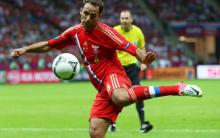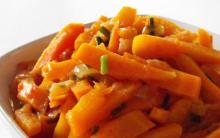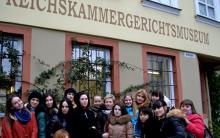Lesson objectives (planned results):
Subject results: know and name the name, patronymic and surname of the great Russian poet, read aloud fluently, consciously, without distortion, expressively, conveying his attitude to what he read, quickly scan the text, observe how the poet glorifies his native nature, what feelings he experiences, use basic text analysis techniques.
Metasubject:
– regulatory control systems: propose a formulation of the purpose and objectives of the lesson, correlate its implementation with the formulation at the end of the lesson, read in accordance with the purpose of reading (fluently, expressively), plan work in a group, evaluate the results of your work at various stages of the lesson;
– cognitive UUD: analyze the text based on the teacher’s system of questions, observe, compare, generalize, find comparisons, epithets in the text, develop attention and memory;
– communicative UUD: express your point of view, participate in dialogue in a group, show tolerance for other opinions.
Personal results: show interest in the poet’s work and reading his poems, treat with pride and respect the heritage of the poet, who glorifies the beauty of Russia in his works, talk about his feelings associated with the perception of the work, reflect on the work being performed.
Resources and equipment:
- Textbook “Literary reading” (grade 3) author. L.F. Klimanova, part 2, p. 55-56;
- Dictionaries: S.I. Ozhegov Dictionary of the Russian language; Dictionary - synonyms of the Russian language;
- Laptop;
- Electronic board;
- Image of a blooming bird cherry;
- Electronic supplement to the textbook;
- Cards for self-assessment (according to the number of students).
During the classes
1. Organizational moment. Emotional charge of kindness. (Let's give each other our smiles and start the lesson in a good mood.)
2. Checking homework.
Expressive reading of A. Blok’s poem “The Crow”. Value judgments.
3. Updating children's knowledge. Goal setting, formulation of the educational task of the lesson.
– Today I invite you to travel back to the distant past and find yourself on Ryazan land. Imagine that we come out onto the steep bank of the Oka. We stand so high that it seems we can touch the clouds with our hands. Everything here excites you and makes you freeze with delight: lakes with silent sedges and white lilies, water meadows with the tart aroma of mint. Nearby is the village of Konstantinovo. Here, on September 21, 1895, a man was born who made this village famous throughout the world. We met this poet in 2nd grade, when we studied the poems “Winter Sings and Calls...”, “Birch”.
– Who do you think our lesson will be dedicated to? (To Sergei Yesenin.)
– Yes, in this lesson we will once again turn to the work of Sergei Yesenin and get to know him better. Guess the riddle and find out the name of his poem.
It's like a snow globe is white,
In the spring it bloomed,
It gave off a delicate scent.
And when the time has come,
At once she became
The whole berry is black.
4. Vocabulary work.
Choose comparisons:
Bird cherry
fragrant like...
white, like...
curly, like...
– What spring is the stream like?
Choose comparisons:
Brook
loud as...
transparent, like...
– Choose words that describe the action of a spring stream.(Murrs, flows, flows, rings, sparkles in the sun.)
– Imagine, spring has come. New, young leaves bloomed on the trees. Remember what they are?
Greens (what kind?)…
-Have you seen the dew? What is she like?
Dew (what?)…
S. Yesenin’s greenery and dew are completely unusual. After reading the poem, we will find out what other dew and greenery there are.
Game “Continue the phrase”.
Insinuatingly... Choose words that are close in meaning (timidly, timidly). Explain and show how it is.
Near the thawed patch... What is this? When are there thawed patches?
Group assignment. Finish the sentence.
1st group: Fragrant bird cherry...
2nd group: Golden green...
3rd group: The stream is like a thunderous wave...(Look in the dictionary for the lexical meaning of the word rattling, explain.Rattles – noisy, making loud sounds.)
Listening to groups and evaluating the results of their work.
– You made wonderful sentences and selected good comparisons. All these lines were used by S. Yesenin to describe the beauty of spring nature. So let's see how it worked out for him.
5. Listening to a recording of a poem to the sounds of music.
6. Conversation on primary emotional perception.
– Did you like the poem? What did you like? What do you remember most? What struck you the most?
7. Working with the textbook. Independent reading by students. Exercise: Read and imagine the pictures described by the poet. What would you draw for the poem? (Children's versions.)
– Now we will analyze the poem, and I hope that you will have more complete and accurate pictures.
8. Physical education minute. Performing exercises “Dennison hooks” from “Gymnastics for the brain” (Kinesiology) (Musical accompaniment by Grieg “Morning.”) (Appendix 2.)
9. Text analysis.
A) – What time of year is described in the poem?(Spring.) Prove it. Find in the text words and phrases that convey the reviving, awakening nature (it blossomed with spring, thawed patches).
– What colors predominate in the poem? (Golden, silver.) What mood do they create?
b) – Now let’s look at the text again. Read the first quatrain and find in it more words that create the impression of a holiday.(Fragrant, curled her curls.) Who is the author writing like this about? (About bird cherry). Who usually prepares for the holiday this way? (Girl.) With whom can the bird cherry be compared? (With a girl, a bride.)
– What word helps not only to see, but also to feel the picture painted by the poet? (Scented). Choose words for the word “fragrant” that are close in meaning. (fragrant, fragrant, fragrant).
- Find in the text what the bird cherry did? (Bloomed with spring.) Why with spring? Are there other phrases “in spring”, “before spring”? What did Yesenin want to say when he said “happy spring”? Like this? (“Hand in hand with spring,” spring is gaining strength and with it the bird cherry blossoms and gains strength.)
– Why does the author call the branches “golden”? Where does this color come from? (From the sun, from flower stamens.) With what intonation will we read these lines?
- Right. Admiringly.
Game “Collect quatrains”.
To make it easier to remember the poem, let's play. Collect the quatrain and read, picking up the given intonation, as if one person is reading. Who remembered? Value judgments.
V) Read the next four lines. What word does S. Yesenin use to describe dew?(Honey.)
- Listen to this word. What word does it come from? (Honey) What kind of honey? (Sticky, viscous.) This means that the dew on the bark of the bird cherry is also sticky and viscous. What words support this? (Slides.) How do you understand this word? (Stretches slowly.) Where does honeydew come from on the bark of a tree? When does she appear? (When the buds burst.)
– What kind of leaves are there when they just appear, hatch from the bud? (Tender, small, juicy, soft.) What word did Yesenin choose to describe greens? (Spicy.) Why? (Spicy is bitter, aromatic in smell and taste.) Why are greens in silver? (Glistens with dew.)
Conclusion. So, S. Yesenin describes a bird cherry that has just blossomed. Very small leaves, still wet, not dry from the juice, shine in silver. There is still very little greenery. What feelings did the poet want to convey? (Delight, joy, admiration.) So, with what intonation will we read the 2nd quatrain? (Admiringly!)
Game “Collect quatrains”.
G) Find more lines in the text that describe bird cherry. Read it.
– What hairstyle did the bird cherry have at the beginning of the poem? (She curled her curls.) And what does the bird cherry tree look like in this quatrain? (He stands hanging himself.) Why? (At first the leaves were not quite in full bloom, but now they have become larger and heavier.) What kind of greenery is it now? (Golden, burns in the sun.) Our bird cherry has changed! Why does S. Yesenin twice refer to the description of bird cherry? (Bird cherry changes and gains strength along with spring.)
– Look at the illustration in the textbook. What do you see? (The first picture shows an awakening bird cherry tree, and the second picture shows a bird cherry tree in full bloom.)
Conclusion. So, the bird cherry has changed, but has S. Yesenin’s attitude towards it changed? (No, he continues to admire even more this amazing creation of nature, this flowering of life.) With what intonation will we read this quatrain? (Admiringly.)
Game “Collect quatrains”.
d) What other image, besides the bird cherry, is present in the poem?(Creek.) Find a description of the stream.
-What word indicates the size of the stream? (Small.) What other words confirm that the stream is small? Where is he running? (In the grass between the roots.) What color is the stream? (Silver.) Why? (It shimmers in the sun, transparent, penetrated by the sun's rays.) Find words that convey the action of the stream? (Runs, flows.) How do you understand the word “flows”? Choose one that is close in meaning (Pours, flows). Can you imagine such a small, timid, gentle, still very young stream, what powerful sounds can it make? (Quiet, calm, timid.) With what intonation will we read this quatrain? (Gently, calmly, a little timidly.)
Game “Collect quatrains”.
f) Are there any other lines about the stream? Read it. Find words that show the action of a stream. (It blows with a wave.) Compare what he did before? (Running, flowing.) Has the stream changed? (Yes, there was a trickle, but it became a wave.) Yes, our stream has gained strength. What other word confirms that the stream has changed? What wave? (Rattles.) How is the stream depicted here? (In strength - strong, in sound - noisy, loud. In character - persistent. It pours over the branches of the bird cherry, as if forcing the proud beauty to pay attention to itself. Who does the stream remind you of? (A young man.)
Looking at the image of the bird cherry, we noticed that it had changed, and now we see that the stream has changed. Is there anything common in these changes? (Yes. Spring is gaining strength and with it nature.) With what intonation will we read these lines? (Persistently, boldly.) Read the last two lines. What can a stream sing about? (About love, about spring.) How will we read these lines? (Gently.)
Game “Collect quatrains”.
and) Attention! Competition for the best reader in groups. Read the entire poem, observing pauses, conveying the author’s mood, as well as your attitude. Value judgments.
10. Homework (differentiated). I think that during the lesson you have become quite familiar with the poem and its lines are still fresh in your head. At home, all you have to do is repeat it.
Bird cherry is not only visually beautiful, but also very useful. Group 1 will tell us why it is useful in the next lesson. (Under the guidance of the teacher, children will look for information in reference books and on a given Internet site, and prepare messages.)
Illustration of a poem - group 2.
11. Summing up. Reflection. Self-esteem.
– What do you think S. Yesenin showed us in his poem? What are his main thoughts? (Love for one’s native land, for nature.) What does it mean to love nature? Is it enough to just admire and admire her beauty? (It also needs to be preserved and protected.) Let us take care and love every blade of grass, every butterfly, every living thing that surrounds us, since our world will be poor, nondescript, dead without the beauty of living nature. (Analyze whether the learning objectives were achieved in the lesson.) What new did you learn about S. Yesenin? What did they open? What feeling did you have after reading the poem? Does anyone have a desire to learn something new about the poet and get acquainted with his other works? Guys, what worked and what didn’t? What was especially difficult and what still needs to be worked on? What would you praise yourself for?
Self-esteem. Evaluating your work in terms of learning new information:
- I learned a lot of interesting things and remembered a lot
- I learned a lot, but didn’t remember everything
- I learned little and remembered little, I still need to repeat it
Value judgments of the teacher with the creation of situations of success, marking the progress of students.
I hope you remember the lesson and you will also want to read other poems by S. Yesenin and through them discover and understand the poet himself.
Subject: Visiting the poet
S. A. Yesenin "Bird cherry"
Goals:
Introduce students to the biography of the poet and his poem “Bird cherry”;
Teach expressive reading of poems;
Explain the concept of "epithet". Learn to find figurative expressions in the text;
Develop aesthetic perception and creative imagination;
To cultivate a feeling of love for the Motherland, for nature;
Develop children's communication skills and ability to work in a team.
Planned results:
Students should know the main milestones of the poet’s life and work;
Be able to find epithets in the text.
Equipment: portrait of the poet, recording of the sounds of spring nature, presentation, musical recording of A. Vivaldi "The Seasons. Spring", coloring pages.
During the classes
1. Organizational moment
2. Update
Teacher: Today we have an unusual lesson. We will visit the famous Russian poet, discover some of the secrets of creating poems and discover the enchanting world of spring nature.
Now close your eyes and listen to the sounds of nature.
Sound recording of nature sounds(spring drops, birds chirping, leaves rustling in the wind, streams babbling).
What pictures does your imagination paint? Describe them.
What time of year do you think it is?
Game "Chain". Students take turns listing the signs of spring.
3. Announcement of the topic and objectives of the lesson
The topic of our lesson is “Visiting the Poet.” We will get acquainted with the work of the great Russian poet S.A. Yesenina
4. Acquaintance with the biography of S. Yesenin
Working with the presentation.
Slide 1. Portrait of S. Yesenin
Sergei Alexandrovich Yesenin (1895 - 1925)
Slide 2. With. Konstantinovo. House-Museum of S. Yesenin
Sergei Yesenin was born near Ryazan in the village of Konstantinovo in the family of a simple peasant. From a young age, the boy grew up in the village, observing the life of ordinary people. But most of all, the future poet was inspired by nature.
Yesenin began writing poetry at the age of 9. And even then the main themes of his work emerged: his native land, the Motherland, the nature of Russia.
Slide 3. Pictures of Russian nature.
Yesenin writes about nature with great love. We are already familiar with the work of this poet. Remember the poems “Winter Sings and Calls”, “Good Morning”, “White Birch”.
Slide 4: bird cherry tree.
It's like a snow globe is white,
In the spring it bloomed,
It gave off a delicate scent.
And when the time has come,
At once she became
The whole berry is black.
Prove that the riddle describes bird cherry.
Teacher: In the midst of spring, when the sun no longer skimps on warmth, the bird cherry blossoms. Its fragrant flowers envelop the branches in a lush snow-white cloud. In this outfit, the bird cherry looks like a young bride, shyly covering herself with a veil.
Let's look at what S. Yesenin wrote about bird cherry.

5. Initial acquaintance with the text
The teacher reads the poem expressively.
The lyrical narrative is different in that the author describes not an event, but feelings and mood. Look, there are no events in the text, and yet, it evokes certain thoughts and gives joy. The poet shares with us his sense of beauty, his delight. A bright picture of the onset of spring is immediately drawn in the imagination. These are streams, golden twigs, and honey dew. The poet managed to convey not only the colors, but also the sounds and even the smells of spring.
6. Analysis of the poem
A) Read the text yourself.
Buzzing reading.
B) Draw a mental picture that appears when reading these lines.
Orient students that there are two lyrical characters in the text: the bird cherry and the stream.
B) Linguistic commentary
Working with a presentation
The slides contain images of natural phenomena. Students must comment and explain the meaning of the words.
Honey dew - drops of dew with the smell of honey, fragrant, sweet;
Spicy greens - greens with a pungent spicy smell, fragrant;
Shines in silver - these are bird cherry flowers, they are white, looking like molten silver.
A thawed patch is a place where the snow has melted and the ground is visible.
The greenery burns in the sun - these are drops of dew shimmering and sparkling in the sun's rays.
The wave is thunderous - the water murmurs loudly.
It splashes - splashes of water reach the tree.
Under the steep slope - under the cliff.
D) Explanation of the term "epithet"
Please note that the author gives a description of each item. The bird cherry is fragrant, the branches are golden, the dew is honey, the greens are spicy. One single adjective, but how subtly the qualities are noted. The result is a complete picture of the landscape. Such words are called epithets.
An epithet is a figurative definition of an object. They help describe the appearance of an object, convey its color, condition, and also express feelings and mood.
D) Consolidation
Let's try to find epithets for the word "cherry bird" on our own.
(white, fluffy, fragrant, fragrant, spreading, cheerful, young, slender).
Find color epithets in the text. (silver stream, golden greens)
Yesenin paints spring in gold and silver colors. This helps to create a special picture of nature - delicate, subtle and incredibly rich.
Find epithets in the poem that emphasize the qualities of the subject
(honey dew, spicy herbs, fragrant bird cherry)
(with a young girl. She has “golden branches that curled her curls”)
What does the stream look like then? Why?
(to a young guy. He “sings a song to her insinuatingly”)
What does "ingratiatingly" mean?
(quietly, trustingly)
Find evidence in the text.
7. Consolidation of what has been learned
A) Work in groups. A coloring book with a picture of a bird cherry tree and a stream has been prepared for each group. Students must color the drawing, choosing the colors indicated by the author. While working, you can turn on the musical recording of A. Vivaldi “The Seasons. Spring”.
B) Explain your choice of colors. Choose epithets for the words: stream, bird cherry, grass, sky.
8. Expressive reading of a poem
9. Reflection
What new did you learn in class today?
What mood did Yesenin’s poetry give you?
What else do you want to know about the poet?
10. Grading and homework
Come up with a fairy tale about a stream and a bird cherry tree. Try to use epithets in the text. Write down the examples you come up with in your notebook.
Re-read the first four lines of the poem. How do you imagine a sparrow? Did the expressive words (epithets) gray, nimble and the comparison like a mouse help you in this? How do you understand the phrase eyes - beads?
I imagine a sparrow as a tiny gray bird, fast and elusive, like a mouse.
Epithets certainly helped me.
After all, they are the ones who convey the appearance and “character” of a sparrow, talking about its nimbleness, dexterity and evasiveness.
The phrase “bead eyes” gives me the idea of small and bright peepholes, like clear glass.
They sparkle and shine like precious stones in the sun.
Sasha Cherny. Elephant
Try to write a funny story about an elephant yourself. Write down her plan.
A funny story about an elephant: “Where the trunk is, there is the front!” for 3rd grade.
This story happened to one very absent-minded elephant, Pasha, and taught him to be attentive.
One morning Pashka the elephant wakes up and, as usual, without combing his hair or looking in the mirror, he decides to go for a walk outside.
An elephant came out and was walking down the street, and somehow it was inconvenient for him to walk - his paws were in the way.
It’s strange - Pashka the elephant thought - this has never happened to me, so that my paws get in the way, but he moved on.
He reached the river and wanted to drink some water. I stuck my trunk into the river, but the trunk didn’t get any water.
It’s strange - the elephant Pashka thought again - this has never happened to me, that water would not get into my trunk...
How am I going to drink now? - Pashka the elephant was scared.
Hello Pasha! Why are you walking backwards?
And stick your tail in the river?
Is this some kind of game?
Let me play it too!!!
Wow! - thought the elephant Pashka - is it that I didn’t notice in the morning that I walked to the river backwards? -
Wow!!! I became completely absent-minded.
The elephant Pashka turned his face towards the river, lowered his trunk, drank some water and decided that he would never be so absent-minded again, and would always wash his face in the morning and look in the mirror so as not to confuse his back with his front again.
Plan for a funny story about Pashka the elephant:
1) Absent-minded elephant Pashka.
2) Water does not get into the trunk and the paws interfere with walking.
3) Remark by Mitka the crocodile.
4) Elephant Pashka comes to his senses.
Discuss Sasha Cherny's poems with a friend. What are they about: about animals or about people? What unites the works?
The work of Sasha Cherny talks about the relationship between animals and people.
All poems contain light and relaxed humor, as well as the poet’s call to people to love and care for our little brothers.
Find a collection of poems by Sasha Cherny in the alphabetical catalog of the library. Look at the table of contents. Read several works. Which poem did you like? Write down your opinion about him.
In the library I found Sasha Cherny’s collection “Children’s Island”.
I was interested in the poem "How a girl found her teddy bear"
I like it because of its light irony and ease.
The monologue of a girl with her teddy bear cannot but make you smile.
Although this is not a real bear, but just a toy, the author shows the girl’s love for him, her childhood experiences.
It's very cute and funny.
Find information about the work of Sasha Cherny. Look in the encyclopedia or the Internet. Write a few lines.
A few lines about the work of the poet Sasha Cherny for 3rd grade.
As a child, the poet’s name was Alexander Glikberg, and Sasha Cherny was his creative pseudonym.
Sasha is from Odessa; when he grew up, his mother and father wanted to send him to study at the Belyotserkovskaya gymnasium, but on the contrary, he refused.
The future poet ran away from home and begged on the street so as not to go to school.
One well-known Zhytomyr official noticed the boy and took him in.
This official loved poetry very much and the boy also absorbed his love.
Over time, Sasha began to write poetry.
When Sasha grew up, the official arranged for him to serve in the Zhytomyr customs office.
Sasha worked, but constantly wrote poetry, and after some time he was noticed and his poems began to be published.
So Sasha Glikberg became the poet Sasha Cherny and left Zhitomir for St. Petersburg.
After St. Petersburg, the poet went to study in Germany, then returned and went abroad for five years.
Sasha Cherny has traveled a lot around the world. In 1929 he settled in France, but did not live long.
When he was 52 years old, his neighbors’ house caught fire, he took part in putting out the fire, but he himself fell ill after this incident and died.
He was buried on the territory of the state of France.
Creativity of Sasha Cherny:
Diary of a Reasoner"
"Nonsense"
To all who are poor in spirit"
"Involuntary tribute"
"Satires"
"Knock Knock",
"Living ABC"
"Frivolous stories"
The story "Wonderful Summer"
"Professor Patrashkin's Dream"
"Fox Mickey's Diary"
"Cat Sanatorium"
"Ruddy Book"
A. Blok. Dilapidated hut
Re-read the poem. What picture did you present?
I imagined my grandmother looking out the window at her cheerful grandchildren playing funny in the snow.
The end of the poem gives an idea of the following picture: grandmother and grandchildren drink tea at the table, look out the window, and there spring is coming, the sun is shining brightly and the snow is melting.
A. Block Dreams
What fairy tales are discussed in the poem? Remember and write down their names.
The poem talks about the fairy tales of A.S. Pushkin.
The Tale of the Dead Princess and the Seven Knights is mentioned.
This is what the nanny tells.
This is where the image of the princess who sleeps in a bed made of crystal is taken from.
The image of the heroes can be compared both with the already mentioned fairy tale and with “The Tale of Tsar Saltan.”
Blok borrowed the image of the overseas queen from the fairy tale “The Golden Cockerel.”
A. Blok. Crow
What kind of crow do you imagine? Write it down.
Reading the poem “Crow” I imagine a black and curious crow.
She watches with interest the changes in nature and is glad that it is finally warmer.
S. Yesenin. Bird cherry
What picture appears in your imagination when you read the lines “And the golden branches curled like curls”? Did you like the comparisons? Why?
When I read the lines of this beautiful work, a picture of a magnificent tree, strewn with golden-colored inflorescences, arose in my imagination.
I immediately imagined the May sun illuminating the bird cherry tree.
After all, it blooms in May.
I really liked the comparison of the branch with the curls.
It is original and well conveys the author’s reverent attitude towards the flowering tree.
Think of what else you can compare bird cherry branches to. Write down the comparisons.
I think that bird cherry branches can be identified with a grapevine, airy clouds, lace, a bride's outfit, a necklace.
The teacher and the children watch the blooming bird cherry or examine the twigs.
Educator (tells the children a riddle)
It's like a snow globe is white,
In the spring it bloomed.
The gentle smell of spring,
And when the time has come -
At once she became
The whole berry is black. (Bird cherry.)
Today we will look at flowering bird cherry. Many poems and songs have been written about her. Listen:
The fragrant bird cherry blossomed in spring, And the golden branches curled like curls... The fragrant bird cherry, Hanging, stands, And the golden greenery burns in the sun.
WITH. Yesenin
Look at the amazing transformations that have taken place in the life of the bird cherry. It became covered with leaves and blossomed. And her flowers are very fragrant, fragrant, you just want to inhale this aroma. I'll bend the branches towards you and you can smell them.
The teacher tilts the bird cherry branch so that the children feel the aroma of the flowers.
Now we will look at the bird cherry flowers and find out why the poem says that the bird cherry branches are golden.
Look, the bird cherry flowers are white, and in the middle there are yellow stamens, like small yellow candles. It's them
give the flowers a golden color. Bird cherry has many, many small flowers, but are they located separately?
The children answer.
That's right, they are sitting together. This is called a brush. Small flowers are collected in a brush from the bird cherry tree. There are a lot of brushes, poets compare them to curls, and the branches look golden from the sunlight and the yellowness of the candle stamens. What does “fragrant bird cherry” mean?
Children offer their own answers.
Fragrant means fragrant, fragrant, fragrant, having a pleasant smell.
Children are invited to once again admire the blooming bird cherry and smell its flowers. You can read the poem again.











What professions are there that involve drawing?
Bezdelov fled through the plundered borders
Why do you dream of a fight in a dream?
Why do you dream of blood from the mouth and
Wearing a dress according to the dream book